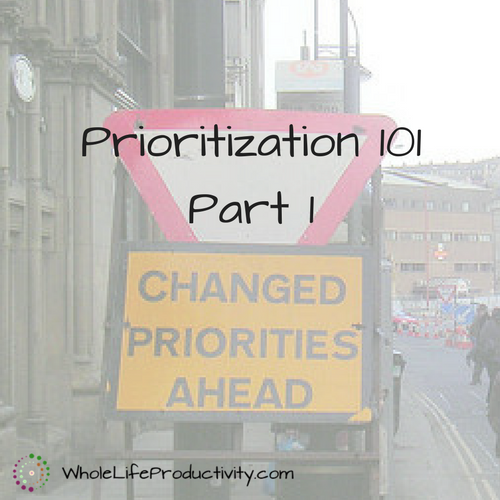
Prioritization 101 – Part 1
There is a lot of talk in the productivity and life-betterment spheres about priorities. “Choose your priorities!” “Set your priorities!” “Work on your highest priorities first!” Articles all about priorites are everywhere. But what exactly are priorities, and why do we need them? And how do we determine what they are?
I’ve been around the productivity and lifehack worlds for a long time. And I’ve seen many methods of determining priorities. I’ve tried most of them as well, and I’ve come to the conclusion that for each person has to determine the method that works best for them. Today and in our next article we will look at various methods of prioritizing tasks, along with their pros and cons.
Priorities
Let’s look at the goal of having priorities.
We all have 168 hours in a week. No one gets more, no one gets less. And those 168 hours are not sufficient to do everything, so we need to pick and choose what we are acutally going to do. Without some sort of frame of reference, we have no way to pick and choose what will be done.
That’s where priorities come in. Priorities are simply a framework within we can choose what to do next.
So let’s look at the more common frameworks for prioriting your tasks.
Why You Need to Have A Framework For Priorization
If you have no way to decide what you will work on first, the tasks will decide for you. Without conscious thought, you will do the things that are screaming the loudest, e.g. those things that are in crisis.
But for those of us who do not work in public safety, doing tasks by crisis management is a poor way to handle things. In crisis mose, we flit from thing to thing, dealing with the latest crisis, and then move onto the next crisis. This method never lets us get to the things that need to be done; it only allows us to deal with the most urgent.
All of the prioritization methods move you away from crisis management and into the important things that will have the most impact on your life.
ABC123
The ABC123 method is one of the oldest methods of figuring out what to do next. It allows you to categorize your tasks into nine buckets, from which you work in the proscribed order.
You start with your task list, and place each task into one of three sections: A tasks must be done today. B tasks should be done today. C tasks are those that have very little importance to you, and/or do not have a time constraint.
A tasks would include things like putting gas in your car’s empty gas tank; paying and mailing bills due in the next week; studying for a test tomorrow; cooking dinner; putting the trash at the curb for pickup tomorrow. B tasks would be things like deciding on a theme for a party you are throwing next month; putting recyclables in the bin; cleaning the old food out of the refrigerator; working on the weekly report due next week. C items would be things like cleaning the grout in the shower; clothes shopping; reading a magazine.
After you have put your tasks into the three letter groups, you then go through and number each group in the order of importance. For example, if your car is running on fumes, that needs to come before grocery shopping because there is no food in the house.
Pros: ABC123 is a good method because it allows you to slice and dice your tasks into manageable chunks. Once you have them classified, you have a straightforward list to work from.
Cons: ABC123 is not much more than a delayed crisis management. It only looks at those things that are time sensitive. In addition, even things that are on the C list can become A tasks if ignored long enough. A call to the dentist at the C level can become an A level tooth extraction if left alone long enough.
Stay tuned for the next article, which will have four more methods of prioritization!
Do you have a method of prioritization? Tweet your favorite to me @LJEarnest using #prioritization.
Image by Neil T. Licensed under Creative Commons. Text added.




